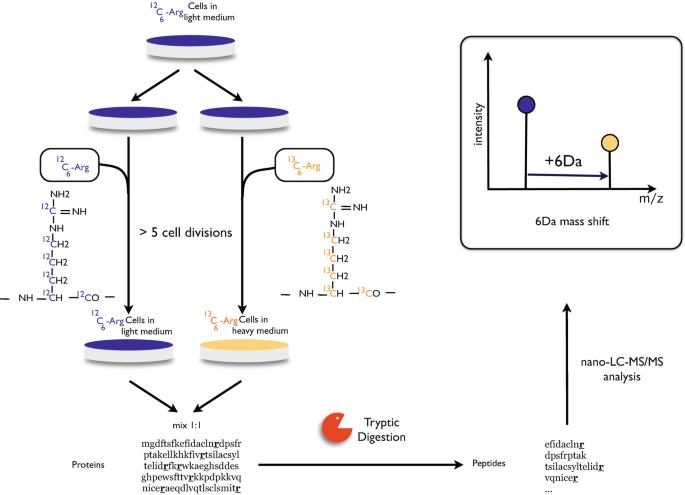SILAC-based Quantitative Proteomics Analysis
SILAC-based quantitative proteomics stands as a trusted and widely employed method due to its stability, efficiency, and precision. For proteomics research that demands accuracy and reliability, Creative Proteomics, a seasoned expert in the field, is your ideal partner, offering professional SILAC-based quantitative proteomics services to empower your scientific endeavors.
What is SILAC-based Quantitative Proteomics
Quantifying the proteome can be done in a variety of ways by introducing stable isotopes, most often using the TMT, iTRAQ or SILAC methods. TMT and iTRAQ can be chemically modified for body fluids and living tissues, while SILAC is used for living cells. Unlike the TMT and iTRAQ methods, SILAC (Stable Isotope Labeling of Amino Acids in Cell Culture) is a robust and high-throughput method for quantifying proteins by introducing isotopic labeling during cell culture. This technology was developed around essential amino acids in mammalian cells and provides a systematic and comprehensive approach to studying protein interactions in the mammalian cellular environment. The SILAC method has a higher protein labeling efficiency and the isolation and purification of proteins does not affect their quantification results, making it a more accurate labeling and quantification method.
The Principle of SILAC-based Proteomics
Unlike TMT and iTRAQ which label enzymatically cleaved peptides, SILAC labels proteins with light or heavy isotopes at the cell culture stage. During cell culture, using essential amino acids (usually lysine and arginine) labeled by isotopes to replace the original amino acids in the culture medium. After 5-6 passages, almost all proteins in the cell will be isotopically labeled. And then, using MS to analyze the samples, and the labeled peptides were relatively quantified through the isotope signals. SILAC is more stable than TMT/iTRAQ and has a higher labeling efficiency of 99%.

Fig. 1. Schematic of SILAC-based proteomics (Hoedt, E., et al., 2014)
Applications of SILAC-based Proteomics
It offers a wide variety of valuable applications. Its efficient and accurate analysis is well suited to medicine, biomedicine, agriculture and forestry, animal husbandry, microbiology, and other life science fields. The applications include biomarker detection, characterizing diseases, drug mechanism research, drug target research, special function protein screening, etc. In summary, it offers a powerful toolkit for researchers seeking to uncover the intricacies of protein dynamics, interactions, and functions within living systems. Its in vivo labeling stability, high labeling efficiency, sensitivity, and flexibility make it an indispensable method for a wide range of life science studies.
Our Services
Due to its high labeling stability, high labeling efficiency and accuracy, SILAC-based proteomics is widely used in many related fields of the life sciences. Creative Proteomics provides high-quality SILAC-based quantitative proteomics analysis services. In addition, we provide TMT and iTRAQ-based quantitative proteomics analysis services. We understand the importance of precision, stability, and efficiency in your research, and our services are designed to meet these exacting standards.

Fig.2. SILAC-based proteomics workflow
Advantages of SILAC-based Proteomics
- In vivo labeling: SILAC is ideal for studies that analyze protein interactions and changes in the natural environment.
- High labelling efficiency and stability: SILAC can label almost all proteins in the cell, typically up to 99%.
- High sensitivity: SILAC can detect and quantify low abundance proteins and is suitable for the identification of low expressed proteins.
- Dynamic proteome analysis: SILAC is well suited to studying the dynamics of the proteome under different conditions or time points.
Creative Proteomics provides comprehensive and high-quality proteomics analysis services. If you are interested in SILAC-based quantitative proteomics analysis, please contact us for more details. Together, we can propel your research to new heights, uncovering the intricacies of protein dynamics within living systems and advancing your scientific pursuits.
Reference
- Hoedt, E.; et al. Stable isotope labeling by amino acids in cell culture (SILAC) for quantitative proteomics. Advances in Experimental Medicine and Biology. 2014, 806: 93-106

